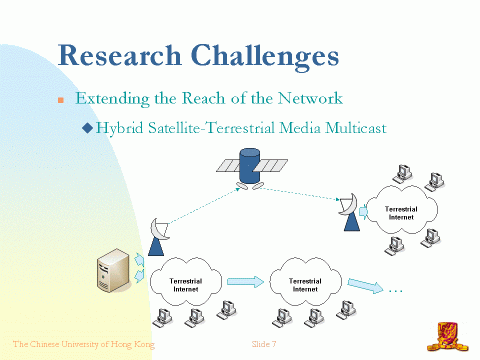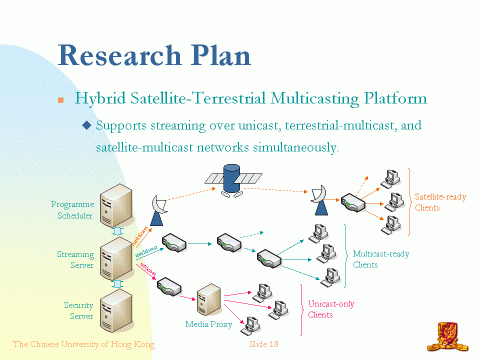 |
||||||||||||||
|
|
||||||||||||||
|
|
||||||||||||||
 |
||||||
|
Multimedia Content Distribution over |
||||||
|
Project Description 1. Introduction Over the past several years we have been participating in the international collaboration efforts organized by JAXA and we have been granted access to the WINDS satellite to conduct research and experiments. This project aims at leveraging the access to the WINDS satellite for the research and experiment of multimedia content multicasting over the WINDS satellite system. This project has two objectives. The first objective is to explore new research opportunities and to tackle the research challenges in delivering high-bandwidth multimedia contents such as audio and video to a large number of users across multiple countries and regions. The second objective is to offer a content distribution platform for JAXA WINDS members to multicast research, cultural, and educational contents to other JAXA WINDS members as well as ordinary Internet users. 2. Research and Development
Given there are now two network channels available, one research challenge is on the routing of media data to a user, who may have access to either one or both of the network channels. Beginning with the simplest routing policy, the server can simply be configured to route media data over the satellite channel whenever the user is known to have satellite connectivity (e.g., identification via user ID or IP address). Otherwise the media data will be routed via the Internet using application-layer multicast (ALM). Taking this idea one step further, the system can also exploit the fact that some users will have access to both network channels, and thus instead of receiving data through a fixed network channel, can monitor the network performance and then dynamically route the data through the best-performing network channel. This idea can be extended even further by exploring the transmission of media data over both Internet and satellite channels simultaneously – multi-path routing. This will be more complex as the characteristics of the Internet channel and the satellite channel, in terms of bandwidth, delay, and loss, are very different. Therefore new media streaming algorithms will need to be developed to compensate for the differences and to exploit the benefits of multi-path routing. This research project comprises two components, namely the network communications module and the content management module. The former is the focus of this research project while the latter will be supported by the CUHK Video Multicast Platform already developed and deployed for use in the Internet. With the CUHK Video Multicast Platform, this project will extend it with a satellite communications module to access the JAXA WINDS satellite for multicasting media contents to JAXA WINDS members. This will enable the system to stream media data to three types of users, namely unicast-only, multicast-ready, and satellite-ready users as shown below.
Principle Investigators Professor Jack Y. B. Lee, Department of Information Engineering Collaborator Japan Aerospace Exploration Agency (JAXA) Funding Agency Shun Hing Institute of Advanced Engineering (SHIAE) |
||||||
|
Contact Webmaster with comments or questions regarding this site. |
||||||

